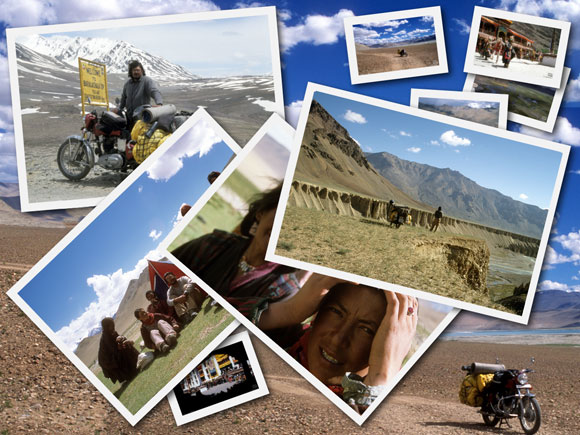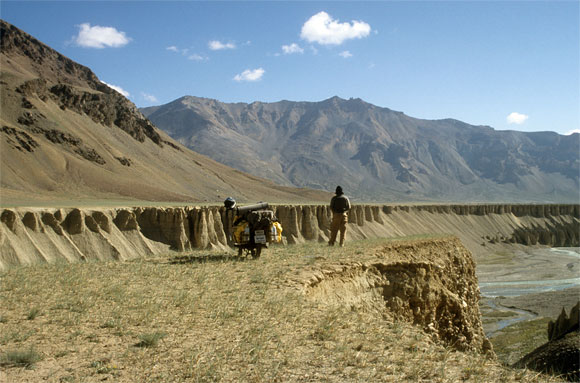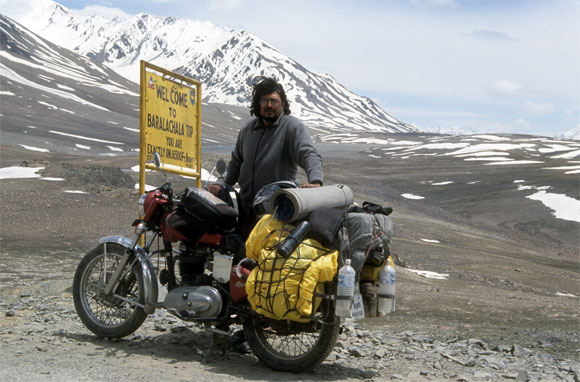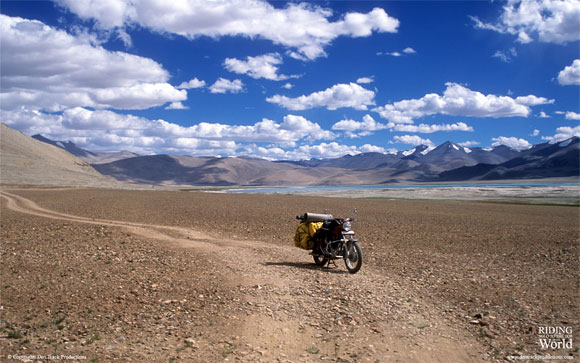Photographs: Courtesy Dirt Track Productions Gaurav Jani
Gaurav Jani writes about his solo bike journey from Mumbai to the Changthang Plateau in Ladakh. Riding Solo To The Top Of The World was the first documentary produced by Dirt Track Productions.
I haven't yet got a chance to talk to strangers who have seen my film. I believe that honest feedback is a must for a filmmaker to know his film and its drawbacks. The screening at the Mumbai International Film Festival started without me. I couldn't attend the screenings at the Calgary and the SIGNS film festival either.
This has left a lot of people in the audience and those who watch the on-line trailer to derive their own conclusions, without knowing the trivia behind the film.
Why did he use a vintage bike? How much fuel did he use? Where did he get it from? What equipment did he use? There is a shot in the film where the camera is panning. How could that happen if he's supposed to be alone?
So here I write about the making of Riding Solo To The Top Of The World, hoping to give you a better insight into the film.
The Start
I wanted to make a documentary series about the romance of travel in India: Five bikers on a two-year ride without a proper film unit or a plan. Without a pre-planned screenplay and film unit, the documentary was to capture the real experience of travel. "Let's just go there and take it from there", like a lot of us who travel footloose without a plan. The film was to capture the little moments that stay with us for a lifetime; the places, the people, the highs and lows of travel.
None of the financers found the idea interesting enough to back it with money. Riding Solo... came about from these desperate circumstances.
Watch the trailer of Riding Solo To The Top Of The World
For more, visit Dirt Track Productions.
My solo bike trip: Footloose in the Himalayas
Photographs: Courtesy Dirt Track Productions
25 Days Of Planning
Giridhar Rao, a very good friend of mine is also a reputed executive producer in commercial Hindi Films. He promised to arrange for a camera. I had been to Ladakh on a group ride before, so I had the clothing and spares ready for the journey. The camera Giri arranged was a Panasonic DVX-100e Mini DV camera. I had never operated a professional camera before. So Rajiv, another very good friend of mine and I started reading the manual to understand the light, ND filter and sound settings.
Both Rajiv and I knew that riding the bike wouldn't be a problem. The problem would be handling the camera. I would have to experiment with the kind of shots I would take, check them, rectify mistakes and learn on the way.
But the biggest problem of all was -- Who would face the camera?
I have been working in films as an assistant director. But that's behind the camera. The other side is for actors and for people who are camera friendly. The body was prepared for anything but the mind just could not get over the fact that I would have to face the camera and talk to it.
Once I accepted this fact, everything fell into place. And throughout, I had the support of fellow 60kph members, the only guys outside Dirt trackers who believed in the film.
My solo bike trip: Footloose in the Himalayas
Photographs: Courtesy Dirt Track Productions
Choice Of Motorcycle
I didn't have a line up of bikes from which I could choose a 350cc Enfield over a 650cc or 1100cc bike. The Enfield in Riding Solo... is my five year old bike and my only option for a ride. Even if I had a heavier machine, I personally think a 650cc is more than enough for a ride like Riding solo... And in my biking years I have shifted from speed and covering distance to travel and stillness. I have done 1000 kms in 19 hours, but doing just 100 kms on Indian back roads is much more fun and satisfying. Riding in India is not about speed, movement or passing by. It is about stillness and knowing Indians and India. That's how the tag line - "Romancing the Roads" - for 60kph came about.
The credit for the bike performing so well during the entire journey goes to two great mechanics. Anthony, my mechanic in Mumbai who has been repairing my bike from the beginning. He opened up the whole bike one week before the ride and made a list of spares and tools.
The bike had two flat tyres during the entire journey, one in Leh city and another in Changthang, both of which are not in the film. Apart from the two flats, the other issue was the usual problem of the bike not performing well at high altitude. Juma, the mechanic in Leh did some magic on the bike with airscrew settings and the bike was performing relatively better. But my "down to bare essentials luggage" was still heavy for an Enfield and on top of that the quality of fuel in Leh was not that great.
Regarding fuel, the tank capacity of the bike is around 14 litres. I could carry 19 litres of spare fuel on the luggage rack. The bike consumed 95 litres of fuel in Changthang. Rest of the fuel came from various Indian Army and Indo Tibetan Border Police camps in Changthang. Midway into the ride I did return back to Leh for fuel and most importantly food supplies. But that portion, once again, was edited out of the film. It was present in the initial cut which was 120 minutes long. We had to remove the whole chunk along with other scenes to bring down the film to around 90 minutes. The shot in the online trailer (just after Changthang statistics) "It's cold here, very cold here..." is from that sequence.
My solo bike trip: Footloose in the Himalayas
Photographs: Courtesy Dirt Track Productions
I was to start the ride from Mumbai. But Giri, now a co-producer in the film advised that I start from Delhi and avoid lugging the hired camera in the scorching heat of Rajasthan and Gujarat. Result, both bike and I went on a train to Jaipur. The ride actually started from Jaipur, 240 kms from Delhi. None of the shots taken before Delhi were kept in the film, as I was still experimenting with the camera.
Discovery Channel has its office in India at Delhi. I met Pankaj Saxena, the programming head and told him about the documentary I was making on my ride, which I also wanted them to telecast on completion. Pankaj was apprehensive and rightly so because I had no plan. None of us knew how the film would shape up.
With minimum luggage, I started off from Vivek Sharma's house in Delhi. The maximum amount of space was occupied by the camera box and camera accessories. The heaviest bag had the bike spares and tools.
Once on the road, each time I had to take a shot, I had to untie the camera bag and tripod, remove the camera, tie the camera bag back onto the bike, set the frame, wear the helmet, ride away from the camera, come back to unpack the camera bag on the bike and pack the camera and tripod back onto the bike. Sounds like a lot of work but any film-maker would go to any length to get a good shot.
There are two shots in the film where I have not operated the camera.
One shot is in the trailer where the camera pans while I am riding. That shot was taken by a cameraman of the Zee News channel. Zee News was doing a feature on paragliding near Rohthang pass at Manali and they too were using the same Panasonic camera. I actually wanted to inquire from the cameraman on what all precautions I should take while taking shots in sub-zero temperatures.
The second shot was taken by a Royal Beast (a Royal Enfield club from Delhi) member whom I had met en route. I wanted the Zee News shot in the film as it was the only shot where the camera moves while I am riding, But quite a few people after seeing the shot thought that my claim of filming my own journey was bogus, so in the DVD cut, we have replaced that shot with me riding past the milestone of Rohthang pass.
My solo bike trip: Footloose in the Himalayas
Photographs: Courtesy Dirt Track Productions
Filming my own journey on the high altitude region was tough physically, but mentally it was satisfying. Any first-time director would be nervous on the sets, crew and cast waiting for his directions. But for Riding Solo... there was no one to judge me or look at me for further instructions. I was filming without any plan or schedule and most importantly, I had complete freedom. A perfect scenario for a first time director.
Having said all that, I was never comfortable facing the camera, even at desolate places. The moment I had to say something to the camera, there would be imaginary millions in the empty landscape watching me.
Apart from that, I had to keep in mind the sound level, my position in the frame and also analyze my speech. The fear was considerably reduced when I lost my way searching for a place called Datta.
The sun was about to set and it was freezing cold. In that moment of panic, the camera was the only companion I had. If I was not filming, I would have found the place easily, but at that time the most valuable things were the exposed tapes rather than the camera, the bike, my health or my biker's ego.
I had to camp to shield the camera and tapes from the cold. My whole approach to the film changed on that restless night. Until then I was taking things lightly -- I had never imagined that I would ever get lost or be in a situation where I would fear for my life. This shift in my approach doesn't come across in the film, but that was the night that changed my whole perspective about the journey. What followed was a more camera friendly attitude and a humbler approach.
My solo bike trip: Footloose in the Himalayas
Photographs: Courtesy Dirt Track Productions
The next turning point in the film was my stay with the Chang pa nomads. The film shifts its attention from my journey to their lives.
Camping with the Chang pas satisfied and enriched me as a filmmaker and traveler. As a filmmaker I felt privileged to be documenting their lives and as a traveler I was learning age-old wisdom from people who are always on the move. Travel for them is not about getting sick of work and wanting a break.
It is a hard life when you have to camp in Yak wool tents for a lifetime, live on just milk products, rice and meat. But the Chang pas had found an inner balance. It had come through knowing and accepting their limitations rather than challenging them.
The film here is about my interaction with the Chang pas. It moves from my hardship and problems to theirs. We were camping with very little food. Our lives had a strange resonance, which helped us to understand each other better. When strangers meet, there is no manipulation, no faking of identity.
Out of all Chang pas, there is one Chang pa I formed an emotional bond with -- Tsewang.
Tsewang's character was mightier than the mountains he lived with. I was treated like a family member from day one. We would talk for hours about Chang pa life and how it was changing. Tsewang, being a Buddhist, accepted change as a way of life. Tsewang had a spiritual calm inside him, the wisdom of the world and philosophy of life. The film, like my stay there, was suspended in time. Without me saying anything, Tsewang would still know what was on my mind.
My solo bike trip: Footloose in the Himalayas
Image: HanlePhotographs: Courtesy Dirt Track Productions
Changthang is breathtakingly beautiful, but Hanle, at the southern edge, is my favourite place. Each traveller has his "place", a place where life makes perfect sense. A strange place where one instantly feels at home. It is about how that place makes you feel and how you feel about the place.
It's kind of difficult to explain, but Hanle is the place I could sit and not think about anything. The way I felt at Hanle had nothing to do with the religious ceremony I was attending. Just sitting on the terrace of Hanle Palace and looking at the huge grasslands and the Hanle River, life seemed calm and beautiful.
At Hanle, I also came to know about the remote Chumur monastery where even the National Geographic unit was not given permission in spite of having a letter from His Holiness, the Dalai Lama and the Home Ministry.
From my travel experiences in India, I have learnt that in remote regions, one should never calculate time to reach a place by kilometers. Everyone at Hanle calculated Chumur to be 40-150 kms and that it would take me 5-7 hours to reach the place.
Chumur was remote and none of the Chang pas at Hanle had been there. According to the driver at Hanle observatory, Chumur was a day's ride. The track to the monastery from Hanle is the toughest terrain to ride your vehicle on in Changthang.
A civilian vehicle goes there once every four months to supply rations to the small population of Chang pas at Chumur. The landscape is desolate, with lots of wild life. There were times when I would ride down from a pass on to the grassland to see hundreds of Kiangs (wild asses).
My solo bike trip: Footloose in the Himalayas
Photographs: Courtesy Dirt Track Productions
The ride to the Chumur monastery and back to Hanle was without doubt the toughest ride I did in Riding Solo. That day was the only time I found myself praying and hoping for a smooth run of the bike.
I had left everything at Hanle - even the tool kit - to make the bike lighter. I had to return the same day, so I didn't take any shots with the video camera on the way in order to save time. I reached Chumur in four hours. After a 30 minute interrogation on what I was doing at Chumur, I was allowed to shoot.
The scariest part was riding back to Hanle, for now I had the exposed tapes with me. If the bike had given any problem that day, I would have surely died. No tent, no sleeping bag, nothing but the camera. Chumur was a suicide run in the circumstances, but I had to visit the place since no traveller had ever been there on a bike and the emotion of exploring a lesser-known place overtook all the apprehension and fear.
Apart from Chumur, I had a tough time camping at two grasslands, especially Khargyam. Night at Khargyam was freezing cold. I was praying for sunshine all night. A small stream running beside my tent had partially frozen. My camping equipment was not made for high altitude.
Just like my motorcycle, it is what I own and could not afford an expensive version. For you to get an idea of how cold it was, at 6 am I took out the camera to take a shot of the frozen stream and the camera battery that normally lasts for 2-3 hours died in 2 minutes because of the cold!
My solo bike trip: Footloose in the Himalayas
Photographs: Courtesy Dirt Track Productions
Riding to Marsimek–la, the highest motorable pass at 18,634 feet was also tough, but that was my day off from work. Camera batteries were getting charged at the Army camp. I was not operating the camera or facing it - that day was my vacation on a vacation so as to speak. Getting to Marsimek-la was for the biker in me and not for the filmmaker.
Next day the filmmaker did suffer from the ride to Marsimek-la. This scene was not there in the previous cut, but we have included it in the DVD cut. Here, you will find the jump in the narration commentary. That's because the voice over for this portion was done recently.
Riding Solo... was not tough physically. Riding on the crowded and noisy streets of Mumbai is much tougher than riding in the middle of nowhere.
No matter how much you stress it out, a day's rest is enough to get you going the next day. The trouble I took to take some shots was done to satisfy the film director in me. I wanted the film to have multiple angles, shots that would do justice to the beautiful Changthang.
Riding Solo... was tough mentally, when you experience so much in a short time. So many thoughts pile up and you need someone to talk to, someone from the city who can understand and relate to the perspective. It's tough for the filmmaker to decide where the film is going when there is a constant clash between the filmmaker and the biker who wants to enjoy the ride uninterrupted; without having to stop every now and then to set up a camera.
Riding Solo... came about out of my desire to make my own film. The director in this case is seen behind and in front of the camera, that's why it gives the feeling of being very tough physically. But what I and everyone else went through to complete this film was far more agonizing physically and mentally.
Watch the trailer of Riding Solo To The Top Of The World
For more, visit Dirt Track Productions.










Comment
article